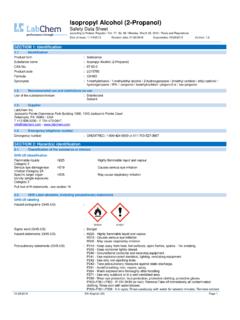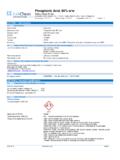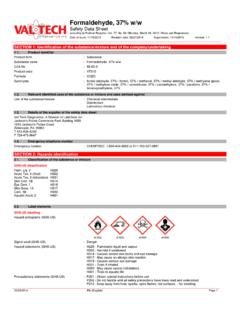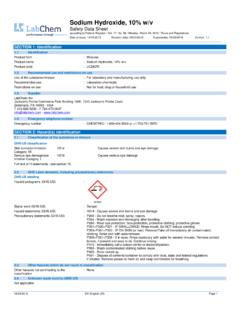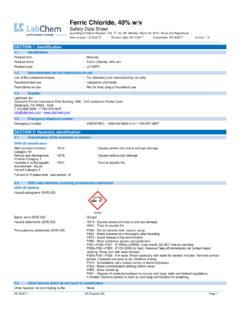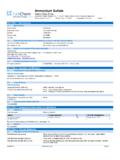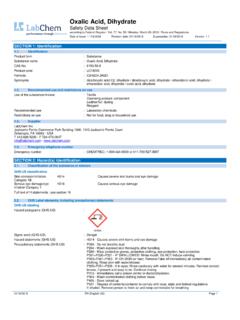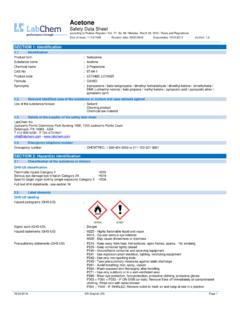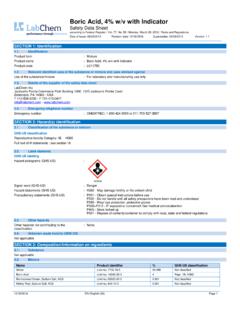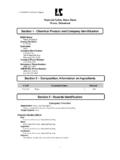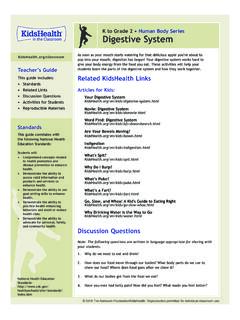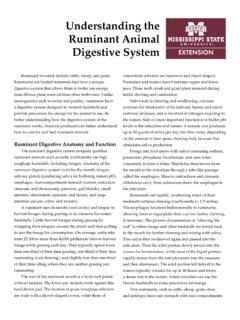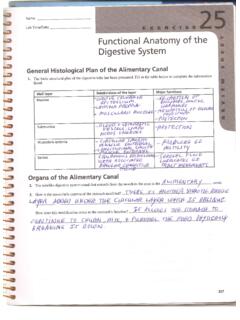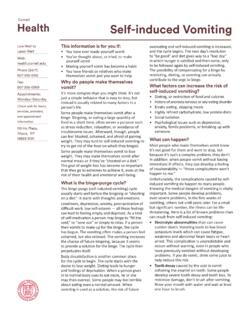Transcription of Material Safety Data Sheet Hexane
1 Material Safety Data SheetHexane- 1 -Section 1 - Chemical Product and Company IdentificationMSDS Name:HexaneCatalog Numbers:LC14920 Synonyms: Hexyl hydride, Identification:LabChem, William Pitt WayPittsburgh, PA 15238 Company Phone Number:(412) 826-5230 Emergency Phone Number:(800) 424-9300 CHEMTREC Phone Number:(800) 424-9300 Section 2 - Composition, Information on Ingredients CAS# Chemical Name: Percent110-54-3 Hexane100 Section 3 - Hazards IdentificationEmergency OverviewAppearance: clear, colorless liquidDanger! Extremely flammable liquid and vapor. Vapor may cause flash fire. Breathingvapors may cause drowsiness and dizziness. Causes eye, skin, and respiratory tract be harmful if absorbed through the skin. Aspiration hazard if swallowed.
2 Can enterlungs and cause damage. Long-term exposure may cause damage to the nervous system ofthe extremities. Possible risk of impaired fertility. Dangerous for the Organs: Central nervous system , respiratory system , eyes, skin, peripheral nervous system , Health EffectsEye:Causes mild eye :Prolonged and/or repeated contact may cause defatting of the skin and dermatitis. Causes irritationwith burning pain, itching, and redness. Absorbed through the skin. There have been no reports ofskin sensitization in people occupationally exposed to n- Hexane . Skin sensitization was notobserved in a maximization test using 25 :2000 CertifiedMaterial Safety Data SheetHexane- 2 -Ingestion:May cause irritation to the digestive tract with nausea, vomiting, and diarrhea. Aspiration ofmaterial into the lungs may cause chemical pneumonitis, which may lead to death.
3 May causecentral nervous system :Causes irritation to the respiratory tract. Exposure produces central nervous system may cause dizziness or suffocation. Hexane vapor concentration can become so high thatoxygen is displaced, especially in confined :Prolonged or repeated skin contact may cause defatting and dermatitis. Prolonged or repeatedexposure may cause adverse reproductive effects. Chronic exposure may cause visual experiments have resulted in mutagenic effects. Peripheral neuropathy symptomsinclude: muscular weakness, paresthesia, numbing of the hands, feet, legs, and arms, unsteadiness,and difficulty in walking and standing. Repeated exposure may cause nervous system abnormalitieswith muscle weakness and damage, motor incoordination, and sensation disturbances. Chronicexposure produces peripheral 4 - First Aid MeasuresEyes:Flush eyes with plenty of water for 15 minutes, occasionally lifting upper and lower eyelids.
4 Getmedical aid at :Flush skin with plenty of water for 15 minutes. Remove contaminated clothing. Get medical aid :Do NOT induce vomiting unless directed to do so by medical personnel. Hexane may be vomiting occurs naturally, have victim lean forward. If victim is conscious, give 2-4 glasses ofwater. Get medical aid at :Remove from exposure area to fresh air immediately. If breathing has stopped, give artificialrespiration. Get medical aid at to Physician:Treat symptomatically and supportively. For ingestion, the stomach should be intubated, aspirated,and lavaged with a slurry of activated charcoal. Protect the airway from aspiration of gastriccontents. Monitor arterial blood gases in cases of severe 5 - Fire Fighting MeasuresGeneral Information:Wear self-contained breathing apparatus and full protective gear.
5 Use water spray to keep fire-exposed containers cool. May accumulate static electrical charges, and may cause ignition of itsown vapors. Extremely flammable liquid and vapors. Vapor may cause flash fire. Vapors areheavier than air and may travel to source of ignition and flash back. Vapors can spread along theground and collect in low or confined areas. This liquid floats on water and may travel to a sourceof ignition and spread Safety Data SheetHexane- 3 -Extinguishing Media:carbon dioxide, dry chemical, or appropriate foam. Water may be ineffective because it will notcool Material below its flash Temperature:225 C (437 F)Flash Point: C to 15 CNFPA Rating:H-1, F-3, R-0 Explosion Limits: :Section 6 - Accidental Release MeasuresGeneral Information: Use proper personal protective equipment as indicated in Section :Absorb spill with inert Material (vermiculite, sand, earth) and place in suitable container fordisposal.
6 Clean up spills immediately. Remove sources of ignition and heat. Avoid runoff intosewers and ditches. Provide ventilation and use non-sparking tools and equipment. A vaporsuppressing foam may be used to reduce 7 - Handling and StorageHandling:Wash thoroughly after handling. Remove contaminated clothing. Ground and bond containers whendispensing. Keep container tightly closed. Keep away from heat and flames. Avoid breathingvapors. Use with adequate ventilation. Empty containers retain product residue and can :Store in cool, dry, well ventilated area away from incompatible materials. Keep away from sourcesof ignition and oxidizing 8 - Exposure Controls, Personal ProtectionEngineering Controls:Use with adequate general ventilation or local explosion-proof ventilation to keep airborne levelswithin acceptable limits.
7 An eye wash fountain and Safety shower should be in the immediate Safety Data SheetHexane- 4 -Exposure Limits:Chemical Name:ACGIHNIOSHOSHAH exane50 ppm TWA; Skin-potential significantcontribution to overallexposure by thecutaneous route50 ppm TWA; 180mg/m3 TWA1100 ppm IDLH500 ppm TWA1800 mg/m3 TWAO ther Hexanes, variousnone listednone listednone listedOSHA Vacated PELs: Hexane : 50 ppm TWA, 180 mg/m3 TWAO ther hexanes: None Protective EquipmentEyes:Wear chemical splash gogglesSkin:Wear appropriate gloves to protect :Wear proper clothing and Safety shoes to protect :Follow OSHA respirator regulations found in 29 CFR Use NIOSH/MSHA approvedrespirator whenever workplace conditions are 9 - Physical and Chemical PropertiesPhysical State:LiquidColor:ColorlessOdor:Gasoline -likepH:Not Pressure:151 mm Hg @ 25 CVapor (air=1)Evaporation Rate:Not mPas at 20 CBoiling Point:62-69 C at 760 mm HgFreezing/Melting Point:-95 CDecomposition Temperature:Not in water:InsolubleSpecific Gravity/ Formula.
8 C6H14 Molecular 10 - Stability and ReactivityChemical Stability:Stable under normal temperatures and Safety Data SheetHexane- 5 -Conditions to Avoid:Ignition sources, excess heat, electrical sparks, confined with Other Materials:Strong oxidizing Decomposition Products:Carbon dioxide, carbon Polymerization:Not known to 11 - Toxicological InformationRTECS:CAS # 110-54-3: MN9275000LD50/LC50:CAS # 110-54-3:Draize test, rabbit, eye: 10 mg mildInhalation, mouse: LC50 = 150000 mg/m3/2 HInhalation, rat: LC50 = 48000 ppm/4 HInhalation, rat: LC50 = 627000 mg/m3/3 MOral, rat: LD50 = 25 g/kgCarcinogenicity:CAS # 110-54-3: Not listed by IARC, NTP, ACGIH, or CA Prop 65 Epidemiology:Occupational polyneuropathy has resulted from Hexane exposures as low as 500 ppm, but theminimum levels of n- Hexane that are neurotoxic in humans have not been established.
9 Nearlycontinuous exposure of animals at 250 ppm has caused neurotoxic :No evidence of teratogenicity or embryotoxicity in animal studies with Hexane has been has been observed in the presence of maternal :Severe testicular damage has been observed in rats exposed to Hexane at concentrations that haveproduced other significant toxicity. Although subneurotoxic doses of its principal toxic metabolite,2,5-hexanedione, can induce progressive testicular toxicity in rats, there have been no reports ofhuman sterility or other reproductive toxicity associated with n- Hexane :Positive results (chromosomal damage in the bone marrow cells) obtained for rats exposed byinhalation to :n- Hexane is a mild irritant and CNS depressant in acute exposure, but its principal effects aredamage to the sensory and motor peripheral nerves, particularly in chronic 12 - Ecological InformationEcotoxicity:No data available.
10 Estimated BCF values = and These values suggest that Hexane willshoe low bioconcentration in aquatic organisms. Estimate Koc value = This product willshow slight soil mobility and is expected to rapidly volatilize from moist surface Safety Data SheetHexane- 6 -Environmental:Terrestrial: Volatilization and adsorption are expected to be the most important fate : Photolysis or hydrolysis is not expected to be important. Atmospheric fate: Expected toexist entirely in the vapor phase in ambient air. Expected half-life: days. Expected tobiodegrade but not to :No information 13 - Disposal ConsiderationsDispose of in accordance with Federal, State, and local 14 - Transport InformationUS DOTS hipping Name: Hexanes Hazard Class: 3 UN Number: UN1208 Packing Group: PG IISection 15 - Regulatory InformationUS FederalTSCA:CAS # 110-54-3 is listed on the TSCA inventory.
